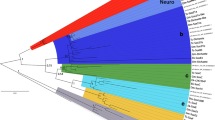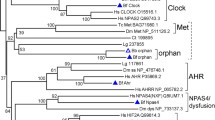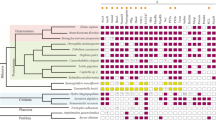Abstract
Most Sox genes directly affect cell fate determination and differentiation. In this study, we isolated two Sox genes: SoxB2 and SoxC from amphioxus (Branchiostoma belcheri), the closest living invertebrate relative of the vertebrates. Alignments of SoxB2 and SoxC protein sequences and their vertebrate homologs show high conservation of their HMG domains. Phylogenic analysis shows that amphioxus SoxB2 and SoxC fall out of the vertebrate branches, suggesting that vertebrate homologs might arise from gene duplications during evolution. The two genes possess similar spatial and temporal expression patterns during embryogenesis and in adults. They are both maternally inherited. During neurulation, they are expressed in the neural ectoderm and archenterons. In adults, they are expressed not only in the nerve cord, but also in the gut, midgut diverticulum, gill and oocytes. These results suggest that amphioxus SoxB2 and SoxC might co-function and have conserved functions in the nervous system and gonads as their vertebrate homologs.
Similar content being viewed by others
References
Bowles J, Schepers G, Koopman P. Phylogeny of the sox family of developmental transcription factors based on sequence and structural indicators. Dev Biol, 2000, 227: 239–255 11071752, 10.1006/dbio.2000.9883, 1:CAS:528:DC%2BD3cXnvVelu7g%3D
Koopman P, Schepers G, Brenner S, et al. Origin and diversity of the sox transcription factor gene family: Genome-wide analysis in Fugu rubripes. Gene, 2004, 328: 177–186 15019997, 10.1016/j.gene.2003.12.008, 1:CAS:528:DC%2BD2cXitVKltrY%3D
Pevny L H, Lovell-Badge R. Sox genes find their feet. Curr Opin Genet Dev, 1997, 7: 338–344 9229109, 10.1016/S0959-437X(97)80147-5, 1:CAS:528:DyaK2sXksVyntr8%3D
Sock E, Rettig S D, Enderich J, et al. Gene targeting reveals a widespread role for the high-mobility-group transcription factor sox11 in tissue remodeling. Mol Cell Biol, 2004, 24: 6635–6644 15254231, 10.1128/MCB.24.15.6635-6644.2004, 1:CAS:528:DC%2BD2cXmtlKltb8%3D
Episkopou V. Sox2 functions in adult neural stem cells. Trends Neurosci, 2005, 28: 219–221 15866195, 10.1016/j.tins.2005.03.003, 1:CAS:528:DC%2BD2MXjslKhsrY%3D
Pevny L, Placzek M. Sox genes and neural progenitor identity. Curr Opin Neurobiol, 2005, 15: 7–13 15721738, 10.1016/j.conb.2005.01.016, 1:CAS:528:DC%2BD2MXhsFShsLY%3D
Wegner M, Stolt CC. From stem cells to neurons and glia: A soxist’s view of neural development. Trends Neurosci, 2005, 28: 583–588 16139372, 10.1016/j.tins.2005.08.008, 1:CAS:528:DC%2BD2MXhtFektbvK
Lefebvre V, Dumitriu B, Penzo-Mendez A, et al. Control of cell fate and differentiation by sry-related high-mobility-group box (sox) transcription factors. Int J Biochem Cell Biol, 2007, 39: 2195–2214 17625949, 10.1016/j.biocel.2007.05.019, 1:CAS:528:DC%2BD2sXhtFWgsLzP
Avilion A A, Nicolis S K, Pevny L H, et al. Multipotent cell lineages in early mouse development depend on sox2 function. Genes Dev, 2003, 17: 126–140 12514105, 10.1101/gad.224503, 1:CAS:528:DC%2BD3sXktlKqtg%3D%3D
Bylund M, Andersson E, Novitch B G, et al. Vertebrate neurogenesis is counteracted by sox1-3 activity. Nat Neurosci, 2003, 6: 1162–1168 14517545, 10.1038/nn1131, 1:CAS:528:DC%2BD3sXosVOiur0%3D
Cremazy F, Berta P, Girard F. Sox neuro, a new Drosophila sox gene expressed in the developing central nervous system. Mech Dev, 2000, 93: 215–219 10781960, 10.1016/S0925-4773(00)00268-9, 1:CAS:528:DC%2BD3cXislaqsrw%3D
Graham V, Khudyakov J, Ellis P, et al. Sox2 functions to maintain neural progenitor identity. Neuron, 2003, 39: 749–765 12948443, 10.1016/S0896-6273(03)00497-5, 1:CAS:528:DC%2BD3sXnt1Wku78%3D
Overton P M, Meadows L A, Urban J, et al. Evidence for differential and redundant function of the sox genes dichaete and soxn during cns development in drosophila. Development, 2002, 129: 4219–4228 12183374, 1:CAS:528:DC%2BD38XnvFGksrg%3D
Malas S, Duthie S, Deloukas P, et al. The isolation and high-resolution chromosomal mapping of human sox14 and sox21, two members of the sox gene family related to sox1, sox2, and sox3. Mamm Genome, 1999, 10: 934–937 10441749, 10.1007/s003359901118, 1:CAS:528:DyaK1MXltF2qu74%3D
Sandberg M, Kallstrom M, Muhr J. Sox21 promotes the progression of vertebrate neurogenesis. Nat Neurosci, 2005, 8: 995–1001 15995704, 10.1038/nn1493, 1:CAS:528:DC%2BD2MXmsFWmt7w%3D
Cremazy F, Berta P, Girard F. Genome-wide analysis of sox genes in drosophila melanogaster. Mech Dev, 2001, 109: 371–375 11731252, 10.1016/S0925-4773(01)00529-9, 1:CAS:528:DC%2BD3MXos1Kgtb0%3D
Cheung M, Abu-Elmagd M, Clevers H, et al. Roles of sox4 in central nervous system development. Brain Res Mol Brain Res, 2000, 79: 180–191 10925158, 10.1016/S0169-328X(00)00109-1, 1:CAS:528:DC%2BD3cXlt1KnsL4%3D
Bergsland M, Werme M, Malewicz M, et al. The establishment of neuronal properties is controlled by sox4 and sox11. Genes Dev, 2006, 20: 3475–3486 17182872, 10.1101/gad.403406, 1:CAS:528:DC%2BD2sXhs1ejtA%3D%3D
Dy P, Penzo-Mendez A, Wang H, et al. The three soxc proteins—sox4, sox11 and sox12—exhibit overlapping expression patterns and molecular properties. Nucleic Acids Res, 2008, 36: 3101–3117 18403418, 10.1093/nar/gkn162, 1:CAS:528:DC%2BD1cXmtlerurc%3D
van de Wetering M, Oosterwegel M, van Norren K, et al. Sox-4, an sry-like hmg box protein, is a transcriptional activator in lymphocytes. EMBO J, 1993, 12: 3847–3854 8404853
Hargrave M, Wright E, Kun J, et al. Expression of the sox11 gene in mouse embryos suggests roles in neuronal maturation and epithelio-mesenchymal induction. Dev Dyn, 1997, 210: 79–86 9337129, 10.1002/(SICI)1097-0177(199710)210:2<79::AID-AJA1>3.0.CO;2-6, 1:CAS:528:DyaK2sXnt1Gjsr8%3D
Maschhoff K L, Anziano P Q, Ward P, et al. Conservation of sox4 gene structure and expression during chicken embryogenesis. Gene 2003, 320: 23–30 14597385, 10.1016/j.gene.2003.07.002, 1:CAS:528:DC%2BD3sXosFyjtb8%3D
Holland L Z, Schubert M, Holland N D, et al. Evolutionary conservation of the presumptive neural plate markers amphisox1/2/3 and amphineurogenin in the invertebrate chordate amphioxus. Dev Biol, 2000, 226: 18–33 10993671, 10.1006/dbio.2000.9810, 1:CAS:528:DC%2BD3cXmsFemsb0%3D
Meulemans D, Bronner-Fraser M. The amphioxus soxb family: Implications for the evolution of vertebrate placodes. Int J Biol Sci, 2007, 3: 356–364 17713598, 1:CAS:528:DC%2BD2sXhtVOmsrvP
Tung T C, Wu S C, Tung Y F. The development of isolated blastomeres of amphioxus. Sci Sin, 1958, 7: 1280–1320 13624735, 1:STN:280:DyaG1M%2FlsVarsw%3D%3D
Lin Y, Liang K, Zhang Y, et al. The expression of amphimdp during amphioxus early development. Gene Expr Patterns, 2004, 5: 253–255 15567722, 10.1016/j.modgep.2004.07.006, 1:CAS:528:DC%2BD2cXhtVahurzK
Putnam N H, Butts T, Ferrier D E, et al. The amphioxus genome and the evolution of the chordate karyotype. Nature, 2008, 453: 1064–1071 18563158, 10.1038/nature06967, 1:CAS:528:DC%2BD1cXntlGjtb4%3D
Schmidt H A, Strimmer K, Vingron M, et al. Tree-puzzle: Maximum likelihood phylogenetic analysis using quartets and parallel computing. Bioinformatics, 2002, 18: 502–504 11934758, 10.1093/bioinformatics/18.3.502, 1:CAS:528:DC%2BD38XivFKrsL0%3D
Holland L Z, Schubert M, Kozmik Z, et al. Amphipax3/7, an amphioxus paired box gene: Insights into chordate myogenesis, neurogenesis, and the possible evolutionary precursor of definitive vertebrate neural crest. Evol Dev, 1999, 1: 153–165 11324100, 10.1046/j.1525-142x.1999.99019.x, 1:STN:280:DC%2BD3M3lvFajtQ%3D%3D
Ma X L, Sun H J, Wang Y S, et al. Study of sonic hedgehog signaling pathway related molecules in gastric carcinoma. World J Gastroenterol, 2006, 12: 3965–3969 16810741, 1:CAS:528:DC%2BD28XotFaqsro%3D
Uchikawa M, Kamachi Y, Kondoh H. Two distinct subgroups of group b sox genes for transcriptional activators and repressors: Their expression during embryonic organogenesis of the chicken. Mech Dev, 1999, 84: 103–120 10473124, 10.1016/S0925-4773(99)00083-0, 1:CAS:528:DyaK1MXjs1ShtLk%3D
Jaillon O, Aury J M, Brunet F, et al. Genome duplication in the teleost fish tetraodon nigroviridis reveals the early vertebrate proto-karyotype. Nature, 2004, 431: 946–957 15496914, 10.1038/nature03025
Wilson M J, Dearden P K. Evolution of the insect sox genes. BMC Evol Biol, 2008, 8: 120 18439299, 10.1186/1471-2148-8-120
Rimini R, Beltrame M, Argenton F, et al. Expression patterns of zebrafish sox11a, sox11b and sox21. Mech Dev, 1999, 89: 167–171 10559493, 10.1016/S0925-4773(99)00199-9, 1:CAS:528:DC%2BD3cXhsFam
Miyata S, Miyashita K, Hosoyama Y. Sry-related genes in Xenopus oocytes. Biochim Biophys Acta 1996,1308: 23–27 8765746
Kanda H, Kojima M, Miyamoto N, et al. Rainbow trout sox24, a novel member of the sox family, is a transcriptional regulator during oogenesis. Gene, 1998, 211: 251–257 9602142, 10.1016/S0378-1119(98)00100-0, 1:CAS:528:DyaK1cXjtl2gtL0%3D
Ogushi S, Palmieri C, Fulka H, et al. The maternal nucleolus is essential for early embryonic development in mammals. Science, 2008, 319: 613–616 18239124, 10.1126/science.1151276, 1:CAS:528:DC%2BD1cXht1Knt7w%3D
Yu C, Dong M, Wu X, et al. Genes “Waiting” for recruitment by the adaptive immune system: The insights from amphioxus. J Immunol, 2005, 174: 3493–3500 15749885, 1:CAS:528:DC%2BD2MXitVehsbs%3D
Huang G, Xie X, Han Y, et al. The identification of lymphocyte-like cells and lymphoid-related genes in amphioxus indicates the twilight for the emergency of adaptive immune system. PLoS ONE, 2007, 2: e206 17299586, 10.1371/journal.pone.0000206
Yu Y, Yuan S, Huang H, et al. Molecular and biochemical characterization of galectin from amphioxus: Primitive galectin of chordates participated in the infection processes. Glycobiology, 2007, 17: 774–783 17442707, 10.1093/glycob/cwm044, 1:CAS:528:DC%2BD2sXot1Wkurw%3D
Author information
Authors and Affiliations
Corresponding author
Additional information
Supported by the National Natural Science Foundation of China (Grant Nos. 30700434 and 30671072), the Natural Science Foundation of Shandong Province (Grant No. Y2007D20), the Shandong Provincial Scientific Research Foundation for Excellent Young Scientists (Grant No. 2006BS02009), and the National Basic Research and Development Program of China (Grant Nos. 2007CB815800 and 2007CB947100)
Rights and permissions
About this article
Cite this article
Lin, Y., Chen, D., Fan, Q. et al. Characterization of SoxB2 and SoxC genes in amphioxus (Branchiostoma belcheri): Implications for their evolutionary conservation. SCI CHINA SER C 52, 813–822 (2009). https://doi.org/10.1007/s11427-009-0111-7
Received:
Accepted:
Published:
Issue Date:
DOI: https://doi.org/10.1007/s11427-009-0111-7




